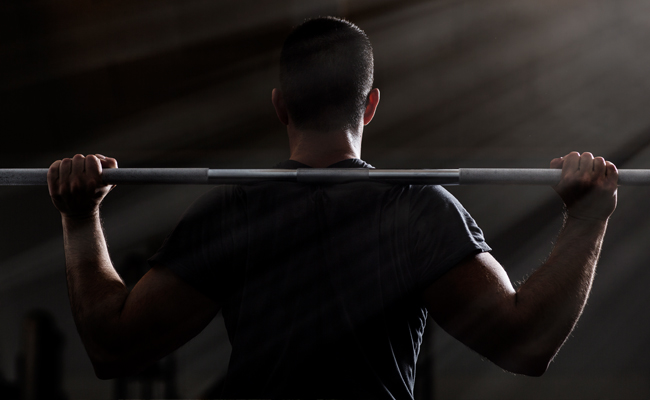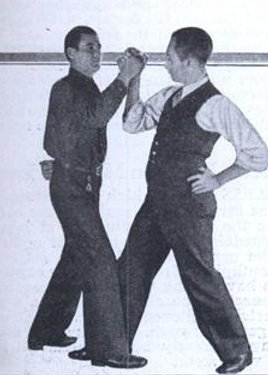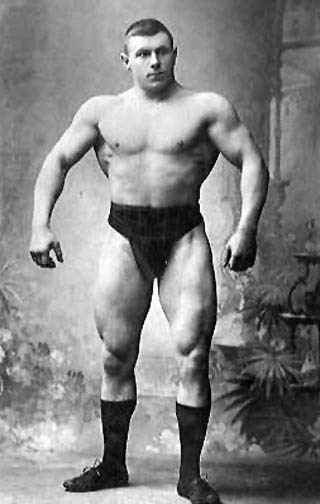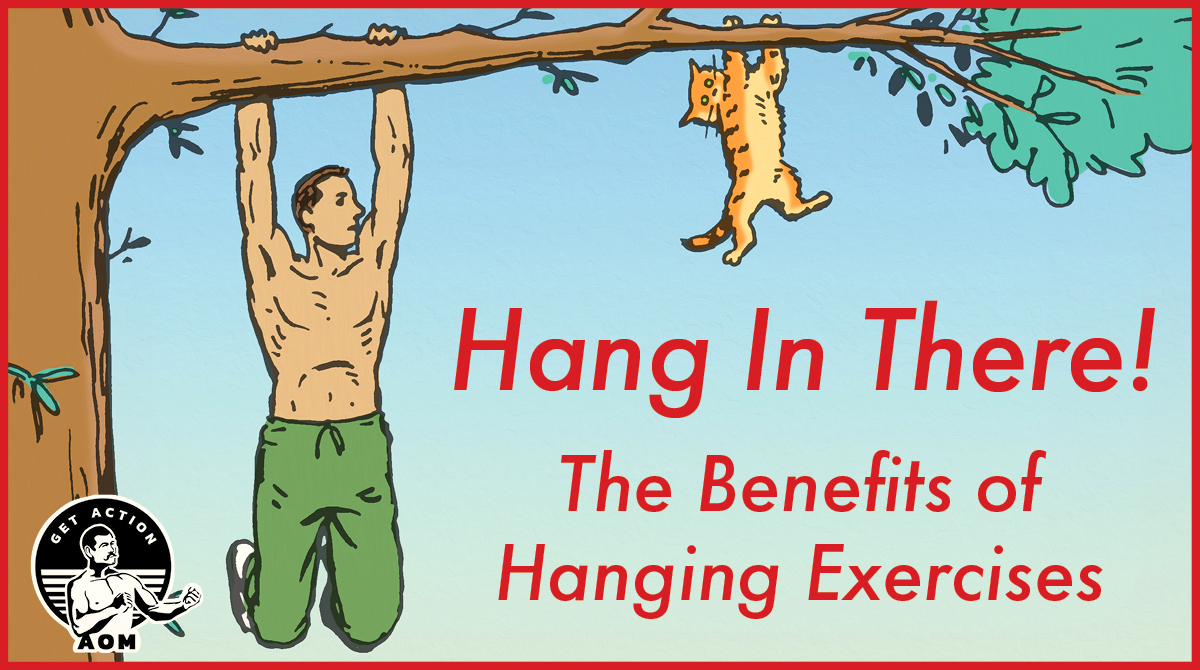
A few years ago, Kate and I got some coaching in MovNat (“Natural Movement”) here in Tulsa. MovNat is all about getting you reacquainted with, and better at, the kind of movements humans once did, well, naturally, but which tend to drop out of our constricted modern routines. To that end we jumped, crawled, rolled, balanced, vaulted, and more. All of it was fun.
The one thing we worked on that was surprisingly uncomfortable for both of us was hanging. Yes, just hanging from a bar.
Despite barbell training regularly and being able to do plenty of pull-ups, I discovered my grip endurance wasn’t that great. In about 15 seconds, it felt like battery acid was flowing through my forearms. And the stretch I experienced in my shoulders and lats revealed how years of sitting hunched over a computer had made me super tight in my upper body.
I didn’t keep up with doing hanging exercises after that time, but after developing some shoulder tendonitis, I brought them back into my regular routine to help me manage the issue. Not only has it helped my tendonitis, but along the way I’ve also discovered other benefits of frequent hanging that apply to everyone. Below I share why you should start hanging more and how to do it.
The Benefits of Hanging
Improved grip strength and endurance. If you’re looking for an exercise to build a grip like a vise, look no further than hanging. When you hang from a bar or other object, the muscles involved with your grip have to hold the entirety of your body weight. If you haven’t hung from a bar in a while, you’ll notice your forearms start to burn with lactic acid in about 10 seconds. The grip strength you develop from hanging can carry over to other grip-dependent movements like the deadlift.
Improved shoulder health and mobility. Think about how many times you lift your arms over your head during the day. If you’re like most people, it might be just a few — putting on a t-shirt in the morning, grabbing something from a cabinet, pulling off your shirt at night. But your shoulders were designed to move in many directions, including up, and when you don’t exercise their range of abilities, they atrophy and tighten.
Hanging from a bar is an easy way to let your shoulders experience their full range of motion. What’s more, the passive stretch it provides can really help loosen and open things up. The stretch you get in your shoulders when hanging is one big reason I’ve incorporated this practice into the warm-up I do before doing shoulder presses and bench presses.
You can up the mobility benefits of the hang by alternating between passive and active hangs and incorporating some swings. More on that below.
Posture correction. The stretch that you get in your shoulders, lats, and back can help alleviate the Quasimodo hunchback that develops from sitting slouched over a computer all day.
Shoulder injury repair. Lots of people are dealing with shoulder pain from shoulder impingement, rotator cuff injury, or frozen shoulder. The typical treatment is rest and physical therapy. And if that doesn’t work, expensive shoulder surgery. But the research shows that the most common surgery used to treat shoulder pain is no more effective than a placebo.
Dr. John Kirsch, an orthopedic surgeon who suffered a shoulder injury himself, saw that surgery didn’t provide effective results, so he looked for other ways to treat his shoulder impingement. He had a hunch that hanging from a bar might help. So Kirsch started to perform this exercise a few minutes a day, and in a few months, the pain in his shoulder was gone. He started having patients with shoulder injuries hang instead of getting surgeries, and they too had the same positive results.
Kirsch began researching the structure of the shoulders with gusto to figure out why hanging from a bar can help heal injuries to this part of the body. His basic idea is that when we go years without using the full range of motion of our shoulders by sitting slumped over our computers, a bone in our shoulder joint called the acromion begins to curve. This shrinks the gap (called the subacromial space) between the acromion and the humerus bone. This is a problem because tendons run in between that gap, and when the gap shrinks, the chance of the acromion and the humerus bones rubbing and pinching those tendons increases. That rubbing and pinching of the tendons is what causes shoulder impingement, the most common type of shoulder injury.
According to Kirsch’s research, regularly hanging from a bar can help straighten out the curved acromion, which increases the gap in the subacromial space, which reduces the pinching and friction on the tendons that pass through that gap.
Kirsch is quick to note that hanging isn’t a panacea for all shoulder injuries. But if you’ve been struggling with shoulder pain and discomfort and nothing seems to work to alleviate it, hanging could be just what the doctor ordered. I highly recommend picking up a copy of Kirsch’s book — Shoulder Pain? The Solution and Prevention — to read all the details on his research and the hanging protocols he suggests for shoulder repair.
Spine decompression. Besides stretching your shoulders, hanging from a bar also decompresses and stretches the spine. It feels really nice and doesn’t require an expensive inversion table.
It’s fun. Hanging may be a little uncomfortable at first, but it’s fun. It’s easy to do and can be done anywhere. Once you get in the hanging habit, you’ll start looking for things in your surroundings you can hang from, like a tree branch, and feel like a kid again.
How to Hang
There are two basic types of hangs: passive and active. Both have their benefits and should be incorporated into a hanging regimen.
Passive Dead Hang

Take an overhand grip on the bar and hang with your feet off the ground. Allow your shoulder and lat muscles to relax. Your body should sink, and your shoulders should be touching your ears. Just hang there and let the weight of your body passively stretch your shoulders, lats, and back.
Active Hang

Start in a passive hang. Now retract your shoulder blades together. This will bring your shoulders down and away from your ears. Stop retracting when your ears reach your elbows. Hold for as long as you can.
Active hanging works the muscles in your shoulders and back. Also, because you’re not allowing all your weight to pull down on your tendons and ligaments, it’s counterintuitively actually easier on the shoulders than a passive hang.
If you have pain in your shoulder(s) during a passive hang, try an active hang first and slowly work your way to a passive hang.
Help! I Can’t Hang From a Bar Yet!
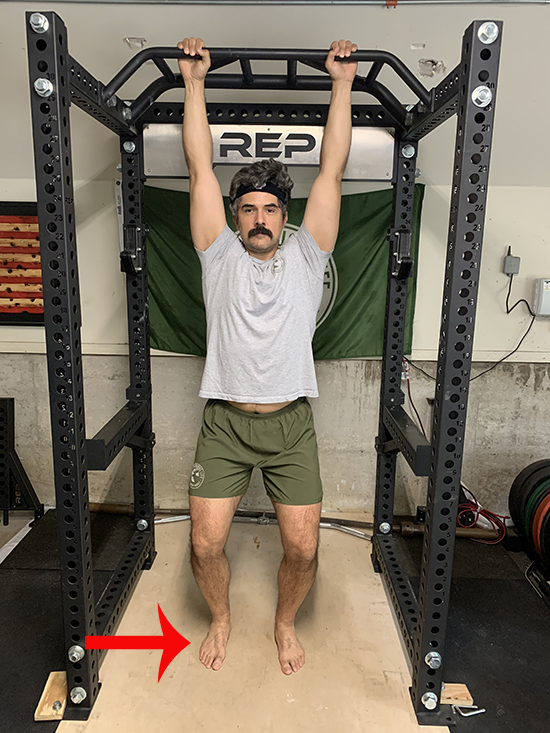
If your current physical condition doesn’t allow you to hang from a bar with your feet off the ground, start with partial or reduced weight hangs. Put your feet on the ground or on a box (if you can’t reach the bar without your feet leaving the ground) and then bend your knees to lower yourself while still standing on your feet. Start first with an active rather than passive hang. As your strength improves, bend your knees more and allow more of your body weight to be supported by your arms, until you can hang with your feet off the ground.
Switching Up the Grip
As you progress with your hanging, feel free to mix up your grips. You’ll work different muscles and feel stretches in different places as you do.
Overhand

This is a pull-up grip and the standard grip for hanging. Start with this one.
Supine
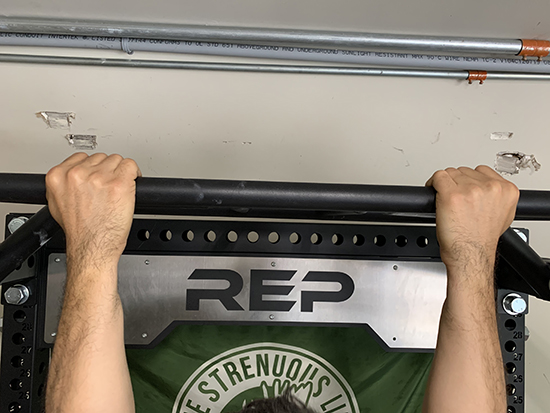
This is the grip you take when you do chin-ups. It provides a great stretch in your triceps.
Alternate Grip

It’s an overhand and supine grip . . . at the same time! Alternate which hand is doing the overhand and which the supine.
Narrow Grip

I really feel the hang in my shoulders and arms more when I take a narrow grip.
Wide Grip
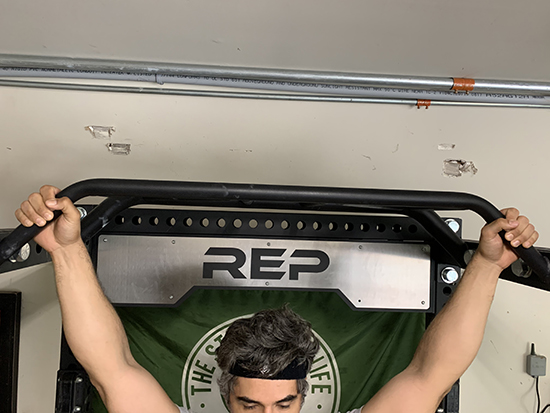
A wide grip gives you a stretch in your lats during a passive hang, and hits the lats more when you active hang.
One-Hand Hang
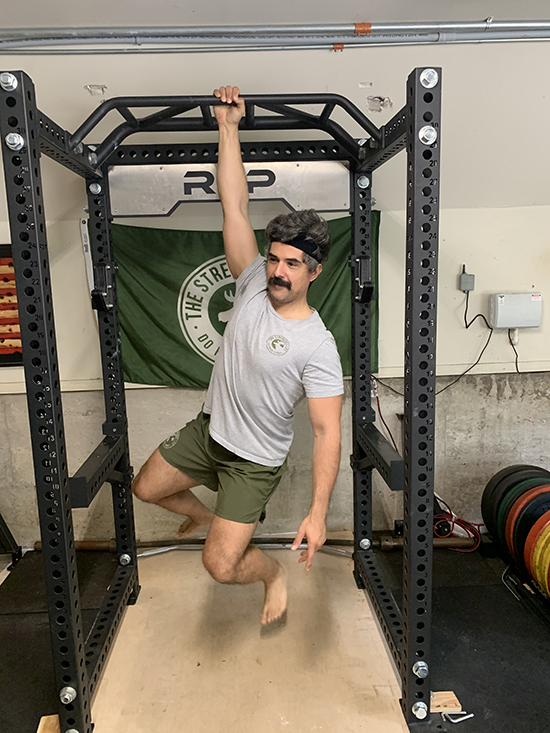
This is a great way to increase the intensity or difficulty of a hang. Instead of both arms supporting the weight of your body, just a single arm does. This is for advanced hangers. Work your way into the one-hand hang.
Hanging on Different Objects

Wide objects. Anything that you can’t get your entire hand around will make hanging harder. Look for big pipes or tree branches to experiment with. In addition to their circumference, the smoothness of the former and roughness of the latter will present unique challenges.
Ledges. Ledges only allow you to hang by your fingers, which makes hanging a lot more difficult. Great for building grip strength.
Rings. The swinging of the rings adds some dynamism to your hang and requires you to use your entire body to stabilize yourself. (See our complete guide to using gymnastic rings for fitness and strength here.)
Odd objects. Thanks to obstacle course races, odd object hanging implements have become a thing. Hanging from things like softballs, bowling pins, and pegs ratchets up the difficulty level of hanging. You can buy odd object implements on Rogue Fitness, or perhaps make them yourself with some ingenuity.
Add a Swing
While hanging in a stationary position provides plenty of benefits, adding a swing to your hang can increase the intensity, work different muscles, and add some diversity into your hanging protocol. MovNat begins with two simple hanging swings that lay the foundation for more advanced climbing skills: 1) side to side and 2) front to back.
Side to Side Swing
Begin with an active hang with an overhand grip. Raise your hips and legs to one side. Let gravity pull your lower body back down and swing you to the other side. The momentum you generate for the swing should come entirely from your lower body.
Also try this little addition to your hanging swings: as your legs swing up to the right, lift your right hand off the bar; when they swing to the left, lift your left hand off the bar. This is a movement that serves as the beginning of traversing a bar sideways.
Forward and Backward Swing
Begin with an active hang. Swing your hips and legs forward. Let gravity swing your lower body back down and to the back. Again, all the momentum should be generated with your lower body. Bring your swing to a stop by lifting your legs up so that they’re perpendicular to the floor. Or you can dismount like a cool dude by letting go at the top of the forward swing.
Hanging Drills
Like I said earlier, I’ve incorporated hanging into the warm-ups I do before shoulder and bench pressing. Here’s a routine that I’ve settled into. Use it as a starting point for your own.
- Passive hang for as long as I can for 3 sets
- Active hang for as long as I can for 3 sets
- Move from passive hang to active hang for as many reps as I can for 3 sets
- Front to back swings x 10 for 3 sets
- Side to side swings x 10 for 3 sets
How to Incorporate Hanging Into Your Daily Life
Besides dedicating training time to hanging, try to find ways you can incorporate this exercise throughout your day.
You can grease the groove with hanging by installing a pull-up bar on a door frame inside your house. Anytime you walk under it, hang from it for 30 seconds.
When you’re out on a walk or a hike, and you see a tree with a killer hanging limb, hang from it!
At the playground with your kids? Hang from the monkey bars!
When your body starts getting stiff and immobile, and you want to get in greater touch with your capacity for movement, just remember to hang in there!
Tags: Exercises


